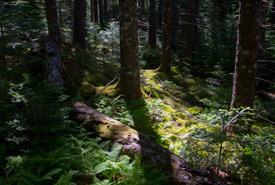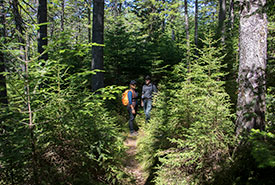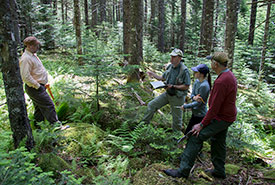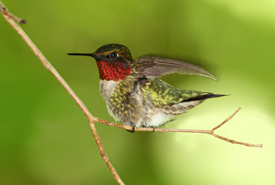Tune in: Let the birds be your guide at Abraham Lake Nature Reserve

Abraham Lake, NS (Photo by Dan Hutt)
Jim Cameron describes Abraham Lake as a quiet oasis away from civilization. That is, until the silence on the trail that weaves through the property is interrupted by one of the area’s many winged residents.
“Standing near the trailhead, the silence is often only broken by the croaking of a raven in the distance, the call of a loon on the lake or a chorus of birds,” says Jim, who helps care for the property. “A continuous chorus of winter wren song frequently accompanies you, as you walk along the trail. If you’re lucky, it’s amazing to see such a small bird produce so much sound.”
The trail begins at a wall of thick forest and opens up into a canopy of aging, giant red spruce trees. This outstanding example of old-growth red spruce forest is now extremely rare in Nova Scotia. The trail continues past these giants, some of which exceed 200 years in age and 30 metres in height, and winds through bogs and thickets of young trees.
“After one kilometre, you can see the lake. It is framed by two large pines, which are still standing despite their exposure to the wind,” says Jim. “It’s clear, unlike a typical lake in Nova Scotia, which is heavily stained by peat.”

Past the lake along the trail, visitors are greeted by scattered mature pine, spruce, birch and hemlock trees. (Photo by Dan Hutt)
Past the lake, along the trail, visitors are greeted by scattered mature pine, spruce, birch and hemlock trees. Further along, the trail meets the lakeshore and a forest with a tall, dense canopy. Overhead, the calls of barred owls surround you, as other birds begin to chime in.
“Bird are singing everywhere, but they are usually difficult to see high in the canopy,” describes Jim. “Identification here is most reliable by sound.”
Related blog posts
Other species make their presence known along the trail, too.
“Bobcats like to leave their calling card along open parts of trail, attesting to the fate of resident snowshoe hare,” says Jim.
Jim visits Abraham Lake regularly, between April and December, to care for the land. Early in the season, he tends to the trails by clearing trees that have been knocked over by the wind. In the summer, he keeps the trails in tip-top shape by ensuring litter and any obstructions, such as blown down trees, are removed. He also teaches visitors about the birds that live on Abraham Lake.
“In June, I do a bird walk on the property, sponsored by Friends of Taylor Head Park Society and the Nova Scotia Bird Society,” he says. “Participants come from all over the province and occasionally from other regions of Canada and the U.S.”

In June, Jim does a bird walk on the property. (Photo by Dan Hutt)
This area is important for birds, as it is somewhat remote, with low-human impact. Loons, spotted sandpipers, common mergansers and northern waterthrushes can be seen nesting on or by the lake, while the open forest is preferred by barred owls and goshawks.
“I was surprised to see a ruby-throated hummingbird along the trail once,” he recalls. “They’re usually associated with flowers and gardens; however, they often use remote locations for nesting.”
When not working on the land, Jim enjoys taking a break by the water.

Ruby-throated hummingbird (Photo by Brian Lasenby)
“My favourite spot on this property is the lake,” he says. “Having lunch on one of the small islands or just canoeing on the lake is as good as it gets.”
Jim hopes that visiting places like Abraham Lake will provide people with a deeper understanding between humans and the natural world.
“I would like Canadians to realize the heritage we have in the forests, wildlife, lakes and rivers. Nature to me is life,” he says. “We need to connect with nature to understand it. Only by understanding can we love the natural world and protect it.”
To learn more about NCC's other Nature Destinations, visit naturedestinations.ca.


